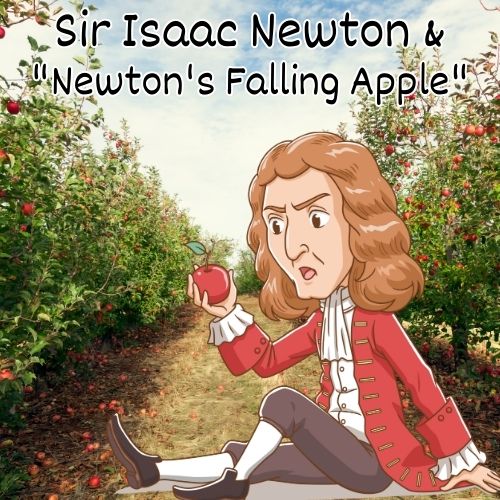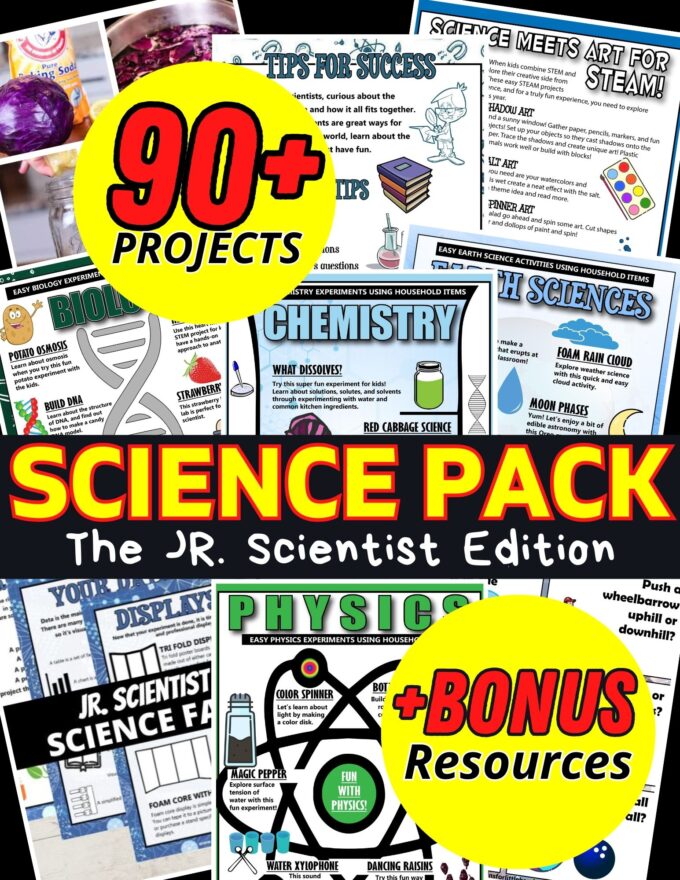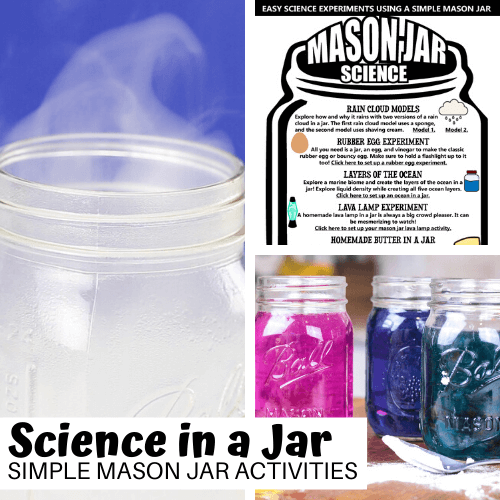

Newton’s Laws Experiment
This post may contain affiliate links.
I have a little lesson on Isaac Newton’s Laws of Motion today. Plus a cool experiment to go along with it called Gravity Beads.

We get the Steve Spangler Science kits in the mail each month. Its a happy mail day when they come. They are a great addition to our science lessons and my kids just have so much fun with them. (Not a sponsored post, just something we really love.) This month’s box was all about inertia and Newton’s laws of motion. Cool stuff. The ultimate favorite of this month’s kit were the gravity beads. But first, a little refresher on motion & gravity for you!
What are Newton’s Laws of Motion & Gravity?

Newton’s First Law states that an object at rest will remain at rest and an object in motion will remain in motion (unless acted upon by force). Another important term is Inertia. Inertia is the tendency of a body to resist a change in motion or rest.
Newton’s Second Law states that force is equal to the mass of the object times its acceleration or F= MA. A force is a push or a pull, and mass is a measurement of the amount of matter the object has. Acceleration measures how fast the velocity (speed with direction) changes. Sobasically it means that you need a force to move an object. The bigger the mass, the greater the force you will need.
Newton’s Third Law says that for every action there is an equal and opposite reaction. Simple? kinda.
Newton’s Law of Gravity says that every particle attracts every other particle in the universe with a force which is directly proportional to the product of their masses and inversely proportional to the square of the distance between their centers. Hu?
Simpler terms: Gravity is a force that tries to pull two objects toward each other. Anything which has mass also has a gravitational pull equal to its mass. The more mass an object has, the stronger its gravitational pull is. Gravity is what keeps you on the ground and what makes things to fall to the ground.
How to Do the Gravity Bead Experiment
Watch to see what it is first. 🙂
So, now that you have a basic grasp of Newton’s laws, (you probably already learned all of this in your physics class in high school right?) you will better be bale to understand how this gravity bead experiment works. It’s crazy cool and really just looks like magic, but it’s physics! This is all based on Inertia and the laws of motion!
All you need is a long strand of beads and a large cup. Really, that’s it! These beads are like the cheap plastic Mardi Gras ones. You can get them anywhere. BUT, the difference here is the length of the strand. This strand is about 50 feet long. If you are going for cost effective, you could try to make our own with the regular beads- just glue many strands together. I am not sure whether it would really be cheaper or not, though. If you are going for ease, pick up this long strand already done for you.
Since posting this, I have seen a lot of people say they see this happen with their Christmas bead garlands! So here is a bead garland that is 26 ft. long . Or maybe you have some at home already?!
It’s best to use a large clear cup or glass so you can watch the process. Put the beads into the cup in circular rows so they do not get tangled up while coming back out. This is really important!

Leave the end of the strand hanging hanging out of the top of the cup. If you make your own beads you will want to do something to distinguish the ends from the other parts of the strands- add a piece of tape to make it easy to find the ends.
When you are ready, give the strand of beads a little tug. Hold the cup high off the ground, so there is more of a pull downward. They will literally start moving and continue moving until the beads run out.
The coolest thing to do is to take a video of it in slow motion so you can really see what the movements look like. You’ll see in our video that the beads move upward in an arc before going down. This is because of the initial pull you give it. It continues in that upward motion until the force of gravity brings it downward. Awesome, right?!
Here’s a tip : Let the beads collect into another cup, then you can keep it going again and again!
Let us know if you try it out!
Want another cool gravity experiment?
Try this Gravity Spinner !
Or try one of my many other STEM projects for kids!
Former school teacher turned homeschool mom of 4 kids. Loves creating awesome hands-on creative learning ideas to make learning engaging and memorable for all kids!
Similar Posts

Fraction – Percentage – Decimal Math Puzzles

Pizza Themed Activities for Kids

Plate Tectonics with Kinetic Sand

Amazing Animals Science Book for Kids

Build a Dinosaur Puzzles & Matching Game

Osmo Game- Pizza Math
We inadvertently do this experiment every Christmas, when our bead garland leaps out of its cylindrical container ! Love it!
Leave a Reply Cancel reply
You must be logged in to post a comment.

Advertisement
Science Projects for Kids: Laws of Gravity and Motion
- Share Content on Facebook
- Share Content on LinkedIn
- Share Content on Flipboard
- Share Content on Reddit
- Share Content via Email
If your children are in need of unique science projects involving physics, look no further than Sir Isaac Newton's laws of gravity and motion. Science projects for kids: laws of gravity and motion can teach your children how applying force to a pendulum inhibits its swing or how centrifugal force can assist in lifting a heavy object.
Testing the laws of physics doesn't have to be difficult for your children. Let them find out how easy the laws of gravity and motion are to comprehend by helping them complete some of these science projects for kids: laws of gravity and motion.
Follow the links below to learn how to make science projects for kids: laws of gravity and motion:
Swing on a Pendulum
Have your children take their science project outside to the playground to learn about pendulums.
Watch an Ounce Lift a Pound
Centrifugal force is at hand with this science project where a lighter object can lift a heavier one. Learn more.
Keep reading to learn how a pendulum works by testing the laws of physics on playground swings.
For more super science projects for kids, check out:
- Science Projects for Kids: Light and Heat
- Science Projects for Kids: Density and Volume
- Science Projects for Kids: The Incredible Universe
Your children can discover the laws of physics when they try to swing on a pendulum at the playground.
What You'll Need:
How to swing on a pendulum:.
Step 1: Have your kids sit in a swing and have their partner push them gently. Time how many times they go back and forth in one minute. Make sure they don't pump the swing. Just let it go on its own.
Step 2: Their partner can use a stopwatch to time precisely one minute while your children count.
Step 3: Then have your children's partner push your children as hard as possible. Again, make sure they don't pump the swing. Count how many times they go back and forth in one minute. Is it any different?
Step 4: Now have them try the same experiment, but pump the swing by themselves. Does adding a force affect the frequency of the swing?
Keep reading science projects for kids: laws of gravity and motion to learn how it's possible for an ounce to lift a pound.
It may sound like it can't happen, but have your children learn about centrifugal force and watch an ounce lift a pound.
How to Watch an Ounce Lift a Pound:
Step 1: Have your children thread a five-foot piece of fishing line through an empty cotton spool. At one end, they should securely fasten the 1-oz object so that it can be whirled about without danger. Then have them fasten a 1-lb rock to the other end of the fishing line.
Step 2: Have your kids grip the spool so that they are also holding the string beneath it. Let the heavy rock dangle down about ten inches. Rotate the light object in a horizontal circle above their head.
Step 3: When the light object is spinning around fast, your children can release their grip on the string below the spool. As they continue to spin the light object, they will see the heavy object begin to rise on the string that goes through the spool. (Make sure they use a strong line and fasten objects securely so that the objects don't fly off.)
ABOUT THE PROJECT DESIGNERS
Swing on a Pendulum by Maria Birmingham, Karen E. Bledsoe and Kelly Milner Halls
Some of the energy your children used to spin the light object around generated a centrifugal force that caused the object to move in a circle. As they applied more energy, the centrifugal force became strong enough to lift the heavy object.
Please copy/paste the following text to properly cite this HowStuffWorks.com article:
Get Your ALL ACCESS Shop Pass here →


Newtons Laws Experiments for Kids
Have you ever wondered why a ball keeps rolling until something stops it or why you feel a pushback when you jump? Get ready to explore the wonders of motion with Sir Isaac Newton’s groundbreaking work with Newton’s Laws Experiments !

Newton’s Laws of Motions
Newton’s Laws of Motion are fundamental principles in physics that explain how and why things move. Each law describes a different aspect of motion, showing us the effects of forces on objects, including concepts like velocity, constant speed, and collisions.
💡Explore more physics experiments here .
Newton’s three laws— Inertia (First Law) , Force and Acceleration (Second Law) , and Action and Reaction (Third Law) —apply to everything from a rolling ball to rockets launching into space. Through these fantastic Newton’s Laws experiments, kids will experience science in action! Read more about each law below!

Newton’s Laws Experiments
Explore these hands-on experiments that bring science to life. They’re perfect for budding scientists eager to understand how things move and interact with forces like gravity.
💡Investigate more gravity experiments [here] .
Grade Level Recommendation: These activities are perfect for elementary and middle school students, especially grades 3-6. They make understanding force and motion in physics fun!
💡Look for free printables with most projects! Plus, grab free science journal notebook pages here.👇

Basketball Bounce Experiment
- What to Do: Drop a basketball with a tennis ball stacked on top of it. Watch the tennis ball bounce higher than usual.
- Science Explanation: The tennis ball bounces higher because it gains energy from the basketball, demonstrating Newton’s Third Law. The action of the basketball’s bounce results in the reaction of the tennis ball moving upward with extra velocity.
Bottle Rocket
- What to Do: Use baking soda and vinegar in a bottle to create pressure, then watch as the rocket launches when the cork or cap releases.
- Science Explanation: The gas produced pushes down, forcing the rocket upward. This action and reaction demonstrate Newton’s Third Law, showing how gas expansion can propel an object in the opposite direction.
Egg Drop Challenge
- What to Do: Create a container to protect an egg from breaking when dropped. Test the container from a height and observe how it cushions the egg.
- Science Explanation: This experiment tests Newton’s First Law, as the egg wants to stay in motion when it falls. Using materials to absorb the impact force helps prevent the egg from breaking, demonstrating how force and inertia affect motion. This is similar to how seatbelts protect us during car collisions by absorbing and distributing the force.
Penny Spinner
- What to Do: Spin a penny on a flat surface and observe how long it stays in motion.
- Science Explanation: This demonstrates Newton’s First Law. The penny will keep spinning until friction (an external force) slows it down. It’s a simple way to see how objects at rest or in motion behave until acted upon.
Rubber Band Car
- What to Do: Build a car powered by a stretched rubber band. Release the car and watch it zoom forward.
- Science Explanation: When stretched, the rubber band stores potential energy. When released, it propels the car forward, demonstrating Newton’s First and Third Laws. The car moves due to the release of energy (First Law), and the pushback of the rubber band creates forward motion (Third Law).
Balloon Rocket
- What to Do: Attach a balloon to a piece of string and release the air. Watch the balloon zip along the string.
- Science Explanation: As air escapes the balloon, it pushes backward, causing the balloon to move forward. This action and reaction illustrate Newton’s Third Law.
Domino Chain Reaction
- What to Do: Arrange the dominoes upright in a series of dominoes on a flat surface. Give the first domino a gentle push and watch them fall over one by one.
- Science Explanation: Inertia keeps the dominos stationary until the force from the preceding domino starts the chain reaction. When one domino pushes another, the second domino exerts an equal and opposite force back on the first. This interaction ensures that each domino transmits enough energy to topple the next one.
Try It Challenge: Stack of Coins (Inertia Tower)
- What to Do: Stack several coins, then flick the bottom one. Watch the coins on top remain stacked.
- Science Explanation: This hands-on activity demonstrates inertia, showing that an object at rest tends to stay at rest unless acted upon by an external force.
Film Canister Rocket
- What to Do: Add a little water and an effervescent tablet to a film canister, seal it, and stand back. The pressure builds, eventually popping the canister into the air.
- Science Explanation: The buildup of gas inside the canister creates pressure. When the lid pops off, the downward force pushes the canister up, demonstrating Newton’s Third Law in a fun and simple way.
💡Investigate more “things that go” experiments here .

What are Newton’s Laws of Motion?
Knowing the basics of the three laws is essential to getting the most out of our Newton’s Laws experiments!
First Law of Motion (Law of Inertia)
The Law: Objects like to keep doing what they’re doing. If they’re at rest, they stay at rest, and if they’re in motion, they keep moving in a straight line at a constant speed—unless an external force acts on them.
Example Activity: Stack of Coins (Inertia Tower) Stack a few coins or washers on top of each other. Flick the bottom coin out quickly, and observe how the coins on top stay mostly in place. This activity demonstrates the concept of inertia, as the top coins resist the change in motion.
- Science Explanation: This is inertia in action! The stack stays still until an external force (your flick) acts on the bottom coin. The coins above want to stay at rest, so they remain stacked while the bottom coin is removed. This is a great way to illustrate how an object at rest stays at rest, and an object in motion stays in motion, unless acted on by an external force.
Second Law of Motion (Force and Acceleration)
The Law: The force needed to move an object depends on its mass and the acceleration it experiences. Heavier objects require more force to move or accelerate.
Example Activity: Popsicle Stick Catapult Build a catapult using craft sticks and rubber bands. Launch marshmallows and see how different levels of force affect the distance traveled. Adjust the angle and magnitude of the applied force to observe changes in motion.
- Science Explanation: The harder you push, the faster and farther the marshmallow flies. This demonstrates Newton’s Second Law, as adding more force increases acceleration , especially for lighter objects like marshmallows.
Third Law of Motion (Action and Reaction)
The Law: For every action, there’s an equal and opposite reaction.
Example Activity: Film Canister Rocket Fill a film canister with a bit of water, add an effervescent tablet, and seal it quickly. The reaction builds pressure inside, launching the canister into the air, similar to how an airplane gains lift.
- Science Explanation: The gas builds pressure inside the canister, and when it releases, the gas pushes downward, propelling the canister upward. This demonstrates Newton’s Third Law, as the action of gas pushing down results in the reaction of the canister moving up.
Why are these Newton’s Laws Experiments important for kids?
Newton’s Laws of Motion are all around us! From riding a bike to playing on a swing, these laws explain why things move the way they do. Kids can see how forces impact our daily lives by understanding and experimenting with these laws.
💡 Encourage your young experimenters to try these activities, observe the outcomes , and consider why they happen. Science is in motion, and it’s all around us every day!

Helpful Science Resources
Here are a few resources to help you introduce science more effectively to your kids or students and feel confident presenting materials. You’ll find helpful free printables throughout.
- Printable Science Project Pack 👇
- Best Science Practices (as it relates to the scientific method)
- Science Vocabulary
- All About Scientists
- Free Science Worksheets
- DIY Science Kits
- Science Tools for Kids
- Scientific Method for Kids
- Citizen Science Guide
- Join us in the Club

Subscribe to receive a free 5-Day STEM Challenge Guide
~ projects to try now ~.


IMAGES
VIDEO